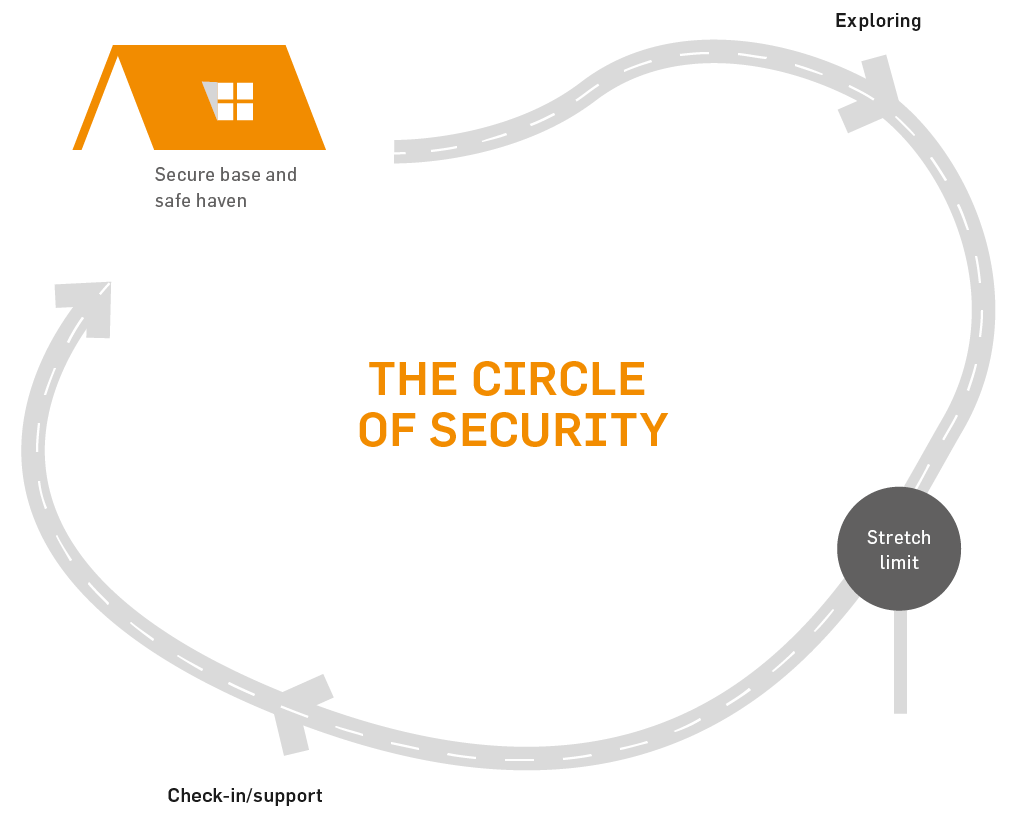Adults and children need security in their relationships. It’s a basic human need. Without security, we feel somehow lost in the world and unsafe. From a young age we orientate around our primary caregivers – normally parents – and form an incredibly close bond and attachment affecting everything in childhood including stress levels, confidence, and physical and mental health.
As children, this bond is strengthened by our daily lives. With a ‘full cup of confidence’ children are able to go off and explore, especially if encouraged by their parents. During these explorations, they use up their security energy, and at some point become somewhat overwhelmed. They then look around (when babies) or move/call etc as they get older, to seek the support of the primary caregivers, or of those to whom they are attached. If they can’t find a primary attachment figure, they may move to a secondary attachment figure, such as grandparents, teachers, etc.
We can represent this cycle of exploration and return with the circle below.

As we mature into adult life, we still require attachment bonds. These tend to be with our friends, colleagues, or partner/spouse. The best leaders create this security for team members. They enable and actively encourage colleagues to go off and explore/take risks (empowerment) and, when needed, encourage the team members to seek support.
If leaders are unable to implement the appropriate strategy at the right time, the colleague starts to have feelings of insecurity in the relationship and doesn’t feel safe. The safer they feel, the more likely they are to take risks, step up to greater responsibility and confidently fulfil their role.
To support colleagues, managers can use three basic frames:
Proximity
Definition: Proximity is about availability. One of a leader’s priorities is to be somehow available for team members at the point of need. This could be on the end of a phone or via email. Attachment figures need to “be around” and to notice where their team members are in the circle and proactively encourage/support.
Example: The manager who makes a point of walking through the office every morning to say “good morning” and stops to have a focused conversation with at least one team member to find out how they are – even if it’s only for a couple of minutes. It helps the manager to remain visible and approachable.
Question: What are you already doing that demonstrates you are available to others?

Openness
Definition: Encouraging another to express their thoughts and feelings.
Leaders’ skills in listening, empathy, and handling emotion will allow team members to speak up about genuine thoughts and feelings, needs, or help. Here we are aiming to listen to what support or encouragement might be required.
Example: The manager who listens when a team member confides in them about something small but personal is more likely to be approached about bigger or more troubling issues causing division in the relationship.
Question: Think of a time you shared something quite small but significant with someone and they really listened. How did that make you feel?

Responsiveness
Definition: Demonstrating empathy and action as a result of an expressed need. When the leader is asked for help/support /encouragement or perhaps, a change of behaviour (e.g. you are too controlling), they then have a responsibility to action this. If we hear, but don’t respond, our relationship is weakened. When we repeatedly listen and then respond our relationship is strengthened. As a result, individuals can take on more responsibility, take more risks, and stretch themselves.
Example: The manager who is asked for advice on time management offers to meet the team member once a week to coach them.
Question: What one thing could you do tomorrow to be more responsive with your colleagues in your team?

